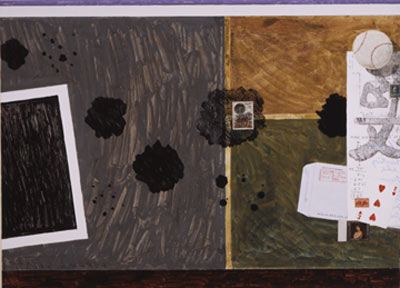Lost but Found
dal 4/11/2004 al 28/3/2005
Segnalato da
Jean Dubuffet
Pablo Picasso
Kurt Schwitters
Paul Klee
Henri Matisse
Marcel Duchamp
Ed Moses
Ed Kienholz
George Herms
Bruce Conner
Charles Arnoldi
Jud Fine
Wallace Berman
John Chamberlain
Claire Falkenstein
Helen Frankenthaler
Robert Heinecken
El Lissitzky
Jerry McMillan
Michael Stone
Stephan von Huene
Tom Wesselmann
4/11/2004
Lost but Found
Norton Simon Museum, Pasadena
The exhibition surveys the rich history and aesthetics of assemblage and collage from 1920 to 2002. Arranged in loose chronological order, the exhibition features important examples from the Museum's permanent collection by some of the most central figures over the last century.

Assemblage, Collage and Sculpture, 1920-2002
As suggested by the title, Lost but Found explores the myriad ways artists
take commonplace, often discarded objects and materials and transform them
into art. These works are largely assembled rather than painted, drawn or
carved, and they are constructed either entirely or in part from
nontraditional art materials. The exhibition surveys the rich history and
aesthetics of assemblage and collage from 1920 to 2002. Arranged in loose
chronological order, Lost but Found features important examples from the
Museum¹s permanent collection by some of the most central figures working in
collage and assemblage over the last century.
French artist Jean Dubuffet coined the term 'assemblage' in 1953, but the
traditions of using found objects in art and collage can be traced to the
first decades of the 20th century. The birth of modern collage occurred in
1912 when Cubist artist Pablo Picasso incorporated a fragment of oilcloth in
a painting to simulate chair-caning and surrounded the piece with hemp rope.
The integration of non-traditional materials in a work of art was at first a
radical act defying convention, but it was only a matter of time before
other artists adopted collage as a vital new means for expression. Collage
was taken a step further when artists began assembling three dimensional
collages or 'assemblages.' The tradition of assemblage advanced with the
avant-garde artists of the 1950s and continues its evolution to the present.
1920s 1950s
The exhibition begins with a look at early collages from the 1920s and 1930s
by Kurt Schwitters (1887-1948), Paul Klee (1879-1940) and Pablo Picasso
(1881-1973). On display are a number of examples from Schwitters' famous
series of collages titled Merz, which incorporate items from every day life
including train tickets, newspaper fragments and candy wrappers. Also on
view from this period is Klee's noted collage Idol for House Cats (1924) and
two versions of Picasso's 1932 collage titled The Diver (Marie-Therése).
The Norton Simon Museum
The Norton Simon Museum is known around the world as one of the most
remarkable private art collections ever assembled. The Museum features a
particularly celebrated Impressionist, Post-Impressionist and 20th century
collection. Complementing the Western art is an outstanding collection of
Asian sculpture from India and Southeast Asia spanning a period of 2000
years.
The Norton Simon Museum is located in Pasadena on the corner of Orange Grove
and Colorado Boulevards at the intersection of the Foothill (210) and
Ventura (134) freeways. The Museum is open every day except Tuesday, from
noon to 6:00 p.m., and noon to 9:00 p.m. on Friday. Admission is $6.00 for
adults and $3.00 for seniors. Members, students with I.D. and patrons ages
18 and under are admitted free of charge. The first Friday of every month
from 6:00 to 9:00 p.m. is free for all visitors. The Museum is wheelchair
accessible. Free parking is available and no reservations are necessary.
For Museum information, please call (626) 449-6840 or visit
Norton Simon Museum
411 W. Colorado Blvd.
Pasadena (CA)



